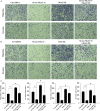Dysregulated circular RNAs in medulloblastoma regulate proliferation and growth of tumor cells via host genes
- PMID: 30402980
- PMCID: PMC6308054
- DOI: 10.1002/cam4.1613
Dysregulated circular RNAs in medulloblastoma regulate proliferation and growth of tumor cells via host genes
Abstract
Circular RNAs (circRNAs) have been demonstrated to be involved in various biological processes. Nevertheless, the function of circRNAs in medulloblastoma (MB) is still unknown. The present study aimed to investigate the expression profiles of circRNAs and related mechanisms for regulating the proliferation and growth of tumor cells in MB. The expression profiles of circRNAs were screened from four normal cerebellum and four MB samples using a HiSeq Sequencer. Bioinformatic analysis was employed to predict the interaction between circRNAs and mRNAs in MB. Subsequently, the expression levels of eight differential circRNAs [circ-SKA3 (hsa_circ_0029696), circ-DTL (hsa_circ_0000179), circ-CRTAM, circ-MAP3K5 (hsa_circ_0006856), circ-RIMS1-1 (hsa_circ_0132250), circ-RIMS1-2 (hsa_circ_0076967), circ-FLT3-1 (hsa_circ_0100165), and circ-FLT3-2 (hsa_circ_0100168)] were validated using quantitative reverse transcription-polymerase chain reaction. Moreover, circ-SKA3 and circ-DTL were silenced using small interfering RNAs and their host genes were overexpressed to investigate their role in the pathogenesis of MB. A total of 33 circRNAs were found to be differentially expressed in MB tissues (fold change ≥ 2.0, FDR <0.05), of which three were upregulated and 30 were downregulated; six circRNAs were experimentally validated successfully. Upregulated circ-SKA3 and circ-DTL promoted the proliferation migration and invasion in vitro by regulating the expression of host genes. This novel study exploited the profiling of circRNAs in MB and demonstrated that circ-SKA3 and circ-DTL were crucial in the tumorigenesis and development of MB and might be considered as novel and potential biomarkers for the diagnosis and new targets for the intervention of MB.
Keywords: circular RNAs; invasion; medulloblastoma; migration; proliferation.
© 2018 The Authors. Cancer Medicine published by John Wiley & Sons Ltd.
Figures





Similar articles
-
Analysis of co-expression networks for circular RNAs and mRNAs reveals that circular RNAs hsa_circ_0047905, hsa_circ_0138960 and has-circRNA7690-15 are candidate oncogenes in gastric cancer.Cell Cycle. 2017;16(23):2301-2311. doi: 10.1080/15384101.2017.1380135. Epub 2017 Nov 9. Cell Cycle. 2017. PMID: 28980874 Free PMC article.
-
Circular RNA profiles and the potential involvement of down-expression of hsa_circ_0001360 in cutaneous squamous cell carcinogenesis.FEBS Open Bio. 2021 Apr;11(4):1209-1222. doi: 10.1002/2211-5463.13114. Epub 2021 Mar 11. FEBS Open Bio. 2021. PMID: 33569895 Free PMC article.
-
Downregulated hsa_circ_0077837 and hsa_circ_0004826, facilitate bladder cancer progression and predict poor prognosis for bladder cancer patients.Cancer Med. 2020 Jun;9(11):3885-3903. doi: 10.1002/cam4.3006. Epub 2020 Apr 6. Cancer Med. 2020. PMID: 32250047 Free PMC article.
-
Tumor-suppressive circular RNAs: Mechanisms underlying their suppression of tumor occurrence and use as therapeutic targets.Cancer Sci. 2019 Dec;110(12):3630-3638. doi: 10.1111/cas.14211. Epub 2019 Oct 25. Cancer Sci. 2019. PMID: 31599076 Free PMC article. Review.
-
Functions of circular RNAs and their potential applications in gastric cancer.Expert Rev Gastroenterol Hepatol. 2020 Feb;14(2):85-92. doi: 10.1080/17474124.2020.1715211. Epub 2020 Jan 14. Expert Rev Gastroenterol Hepatol. 2020. PMID: 31922886 Review.
Cited by
-
Emerging Role and Mechanism of circRNAs in Pediatric Malignant Solid Tumors.Front Genet. 2022 Jan 18;12:820936. doi: 10.3389/fgene.2021.820936. eCollection 2021. Front Genet. 2022. PMID: 35116058 Free PMC article. Review.
-
The therapeutic and diagnostic potential of regulatory noncoding RNAs in medulloblastoma.Neurooncol Adv. 2019 May-Dec;1(1):vdz023. doi: 10.1093/noajnl/vdz023. Epub 2019 Sep 6. Neurooncol Adv. 2019. PMID: 31763623 Free PMC article. Review.
-
The Non-coding Side of Medulloblastoma.Front Cell Dev Biol. 2020 May 27;8:275. doi: 10.3389/fcell.2020.00275. eCollection 2020. Front Cell Dev Biol. 2020. PMID: 32528946 Free PMC article. Review.
-
Diagnostic and therapeutic potential of circular RNA in brain tumors.Neurooncol Adv. 2023 Jun 13;5(1):vdad063. doi: 10.1093/noajnl/vdad063. eCollection 2023 Jan-Dec. Neurooncol Adv. 2023. PMID: 37334165 Free PMC article. Review.
-
The mechanism of non-coding RNAs in medulloblastoma.Oncol Lett. 2021 Nov;22(5):758. doi: 10.3892/ol.2021.13019. Epub 2021 Sep 2. Oncol Lett. 2021. PMID: 34539862 Free PMC article. Review.
References
-
- Louis DN, Perry A, Reifenberger G, et al. The 2016 World Health Organization Classification of Tumors of the Central Nervous System: a summary. Acta Neuropathol. 2016;131:803‐820. - PubMed
-
- Pomeroy SL, Tamayo P, Gaasenbeek M, et al. Prediction of central nervous system embryonal tumour outcome based on gene expression. Nature. 2002;415:436‐442. - PubMed
Publication types
MeSH terms
Substances
LinkOut - more resources
Full Text Sources
Miscellaneous

